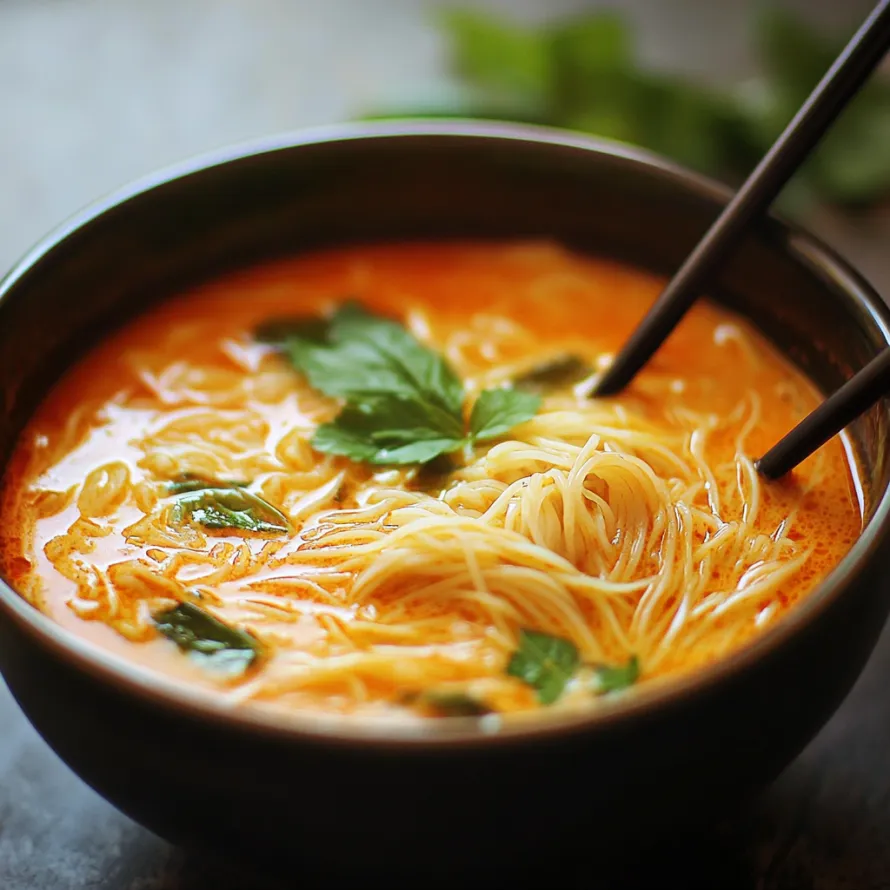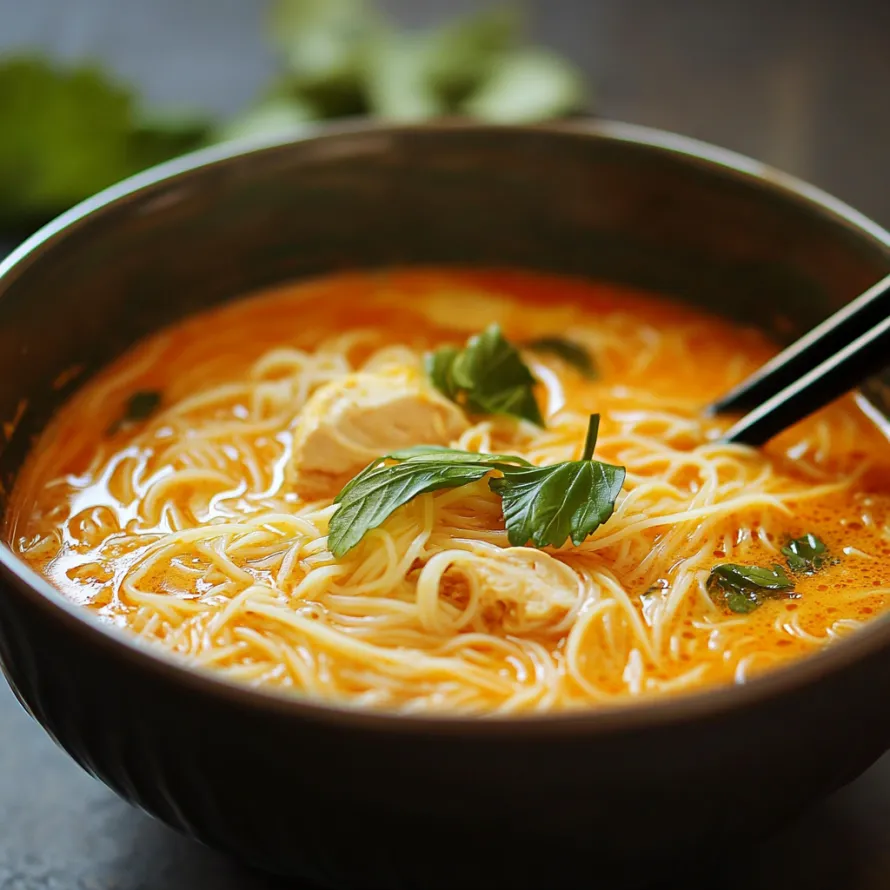 Pin
Pin
This aromatic Thai Red Curry Noodle Soup beats takeout hands down with its deeply flavorful broth. Juicy chicken chunks, smooth rice noodles, fresh cilantro, fragrant basil, and tangy lime juice come together in a comforting bowl that perfectly balances spicy, sweet, tangy, and umami elements.
I whipped this soup up for my family on a really cold night last weekend. Amazing smells filled our kitchen as the curry paste sizzled in the oil. Everyone kept popping in asking when we could eat. When they finally tasted it, the table went completely quiet before everyone started raving. By lunchtime the next day, all the leftovers had vanished.
Key Components
- Coconut Milk: Go with full-fat for the thickest, smoothest broth you can get
- Red Curry Paste: Your soup's flavor foundation bringing depth and spiciness
- Fish Sauce: Gives that special savory kick that regular salt just can't match
- Rice Noodles: Soak up all that tasty broth while staying nice and chewy
- Chicken: Adds protein and turns super tender swimming in coconut broth
- Lime Juice: Wakes up all the flavors and cuts through the coconut's richness
- Fresh Herbs: Cilantro and basil bring freshness and make it look pretty
Making Your Soup
- Start With Aromatics:
- Heat some oil in a big pot over medium. Cook chopped onions until see-through. Toss in minced garlic and grated ginger, cooking just until they smell good but don't brown. This makes the flavor base that'll run through your whole soup.
- Wake Up The Spices:
- Drop the red curry paste into your pot and keep stirring for about two minutes. This step is super important—it wakes up the spices and pushes their flavors into the oil. You'll know it's working when it starts smelling amazing and gets a bit darker.
- Make Your Broth:
- Pour in the coconut milk and chicken broth, stirring until the curry paste mixes in completely. Let it come to a gentle simmer, but don't let it boil hard or your coconut milk might break apart. Give everything a few minutes to get friendly.
- Add Your Chicken:
- Drop chicken pieces into your simmering broth. Cook until they're completely tender and reach 165°F inside. This slow, gentle cooking keeps the meat juicy while it soaks up all those curry flavors.
- Drop In The Noodles:
- Add rice noodles during the last few minutes of cooking. They'll soften in the hot broth but still keep some bite. Don't cook them too long—they'll keep softening in the hot soup even after you turn off the heat.
- Get The Flavor Just Right:
- Right before serving, stir in some fish sauce, brown sugar, and lime juice. Taste it and tweak these ingredients until you get that perfect mix of salty, sweet, and sour. This final step is what makes your soup taste truly Thai.

I'm totally amazed by what fish sauce does in Southeast Asian dishes. My grandma got me using it years back, telling me it was exactly what my early Thai cooking attempts were missing. She nailed it. Now I always keep some in my pantry and splash it into everything from stir-fries to meat marinades. Once you get past how it smells in the bottle, the flavor depth it adds is incredible.
Taste Building Blocks
Red curry paste works as this dish's flavor engine. It mixes red chilies, garlic, lemongrass, galangal, and other spices into one powerful blend. You'll find Thai Kitchen brand in most stores—it's pretty reliable and not too spicy. If you want something more authentic, try Mae Ploy, which has awesome flavor but contains some shrimp paste. Homemade curry paste usually tastes brighter but you'll need hard-to-find stuff like galangal and makrut lime leaves.
Make It Your Own
Thai food's all about tweaking things to your taste. You can swap out chicken for shrimp or cubed firm tofu if you don't eat meat. Veggie-wise, try adding thin-sliced mushrooms, bright bell peppers, baby corn, or crunchy snow peas. If you want different noodle textures, udon works for chewiness or vermicelli for something more delicate. Green curry paste makes an equally yummy soup but with more herby flavors compared to the red stuff.
Keeping Leftovers Fresh
If you've got soup left over, store all the parts separately. Keep your broth in a sealed container in the fridge for up to three days. Put cooked noodles in their own container with a tiny bit of oil mixed in so they don't stick together. When you're ready to eat again, warm the broth slowly on the stove until it bubbles, then toss in the noodles just long enough to heat them without making them mushy. Don't try freezing this soup—thawed coconut milk gets weird and the noodles turn to mush.

This Thai Red Curry Noodle Soup has become my favorite way to wow friends without spending forever in the kitchen. It tastes way more complex than the actual work involved, and it looks absolutely stunning with all its colors. I crave this particular mix of spicy, creamy, and tangy more than almost anything else I make. The way the coconut milk softens the heat while the lime juice cuts through the richness makes every spoonful perfectly balanced.
Recipe Q&A
- → How can I make this dish vegetarian?
- Absolutely! Swap chicken for tofu or extra veggies like carrots and mushrooms. Use veggie broth instead of chicken broth, and soy sauce instead of fish sauce.
- → Is this soup really spicy?
- It depends on your curry paste. Store-bought ones are usually medium spicy. Tone it down with more coconut milk or less paste, or turn up the heat with Thai chilies.
- → Can I prepare this ahead of time?
- Yep! Make the chicken and broth a day earlier. Just warm it up before serving, toss in the noodles to cook, and finish off with herbs and lime juice.
- → What’s a good substitute for fish sauce?
- If fish sauce isn’t your thing, opt for soy sauce with a squeeze of lime, or try vegan fish sauce made from seaweed.
- → How long does this keep in the fridge?
- It’ll last 2-3 days in the fridge. Keep the noodles separate if you can, so they don’t soak up all the broth and get too soft.
- → Can I freeze leftovers?
- Yes, but freeze the chicken and broth without noodles or herbs. When you’re ready, thaw it, reheat, and toss in fresh noodles and herbs.
